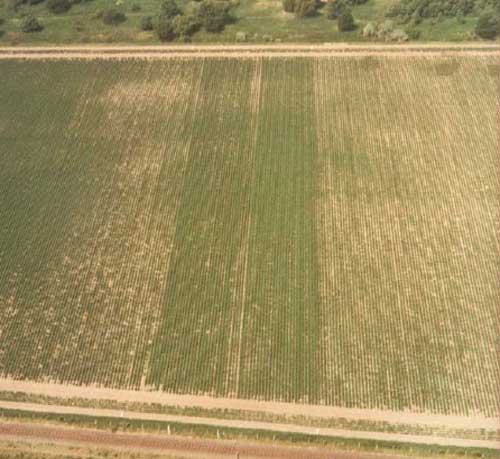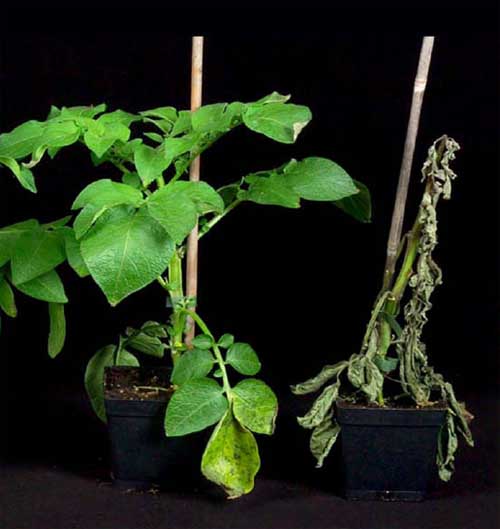Sustainability-Plant Disease Control
Published on 17 November 2009 in Sustainability and Communities , Climate, water and energy
Introduction
Food security is, and will remain, high on government agendas worldwide, with the UN predicting that food production will need to increase by 50% by 2030 and to double by 2050 to meet rising demands. Since land is a finite resource and bringing new land into crop production is unsustainable, we must increase crop yields on existing farm land. A major way to contribute to this increase is by improving control of pests and diseases through better surveillance, optimising chemical inputs and developing resistant crops.
Potato is the world’s fourth largest crop (and the third largest food crop) and is second only to barley in Scotland. Here, over a million tonnes of potatoes are produced each year at a value to the economy of £150-200 million. Due to the high health status of potatoes grown in Scotland, approximately 25% of production is high value seed, most of which is exported. Unfortunately, pests and diseases are responsible for major losses to potato in Scotland, as they are in other parts of the world. It has been estimated that (across the UK as a whole) as much as 15% of seed and ware crops are lost to pests and diseases each year(1), despite the use of pesticides costing over £100 million. To add to this problem, under some circumstances some older pesticides may be harmful to the health of people and the environment, so recent EU legislation (Directive 91/414/EEC) is aiming to remove them. In the long-term, this is undoubtedly a good thing, but it must be recognised that pesticides play a vital role in controlling pests and diseases. For example, it was recently estimated that without chemical control, yearly losses to potato in the UK due to just one disease, late blight, would increase from £55 million to £363 million (almost half the UK’s potato production)(2).
(1) CSL (FERA) (2001) Potatoes: a survey of diseases 2000/01.
(2) Potato Council Project Report 2009/02: Pesticide availability for potatoes following revision of Directive 91/414/EEC: Impact assessment and identification of research priorities.
Key Points
Our challenge is to find ways to reduce crop wastage (in this case potato) caused by pests and diseases in a way that is sustainable; by optimising the use of pesticides, whilst protecting people and the environment both now and into the future, yet still supporting a profitable potato industry.
Research Undertaken
- SCRI is carrying out research on methods of disease control that will help to reduce or eliminate the need for pesticides. These methods include improved surveillance techniques, a better understanding of the environmental survival and spread of pests and pathogens, and the development of resistant varieties. Durable host resistance is seen as the ideal and most ‘environmentally friendly’ way to control diseases because agrochemicals do not need to be deployed.
- New diagnostics have been developed that are being used for both statutory and commercial testing, as well as providing tools for our research. These include a new molecular test for potato cyst nematode used in conjunction with the Scottish Government through SASA (Science and Advice for Scottish Agriculture) to allow increased capacity in testing as part of new EU legislation (2007/33/EC).

Figure 1: Reductions in the use of pesticides could have serious implications for protecting potatoes from pests and pathogens, including potato cyst nematode. The picture shows two strips in the centre of the field treated with nematocide.
- As with statutory testing, avoiding contamination by pests and pathogens will reduce the need for pesticides. Our aim is to achieve this through a better understanding of the survival and spread of pests and pathogens in the environment. For example, we are investigating the role of wild plants in the survival and spread of the bacterial potato pathogens Pectobacterium and Dickeya (formerly Erwinia) and applying this knowledge to reducing pathogen spread to the potato crop.
- Resistant cultivars are a major weapon against pests and diseases that, due to the ready availability of pesticides, have so far been under-exploited. At SCRI we aim to combine different types of resistance to develop cultivars that are resistant to a wide range of pests and pathogens and which remain so over a long period of time (durable resistance). To enable us to do this we are examining the interactions between pests / pathogens and their potato hosts to identify the genes and pathways involved in resistance. For example, we have recently shown that the late blight pathogen, Phytophthora infestans, injects up to 500 proteins into the plant cell, some of which target major defence pathways. Using similar knowledge in Pectobacterium we have shown in a model experiment that it is possible to develop resistant potato plants using a transgenic approach. Important defence pathways against viruses have also been identified and are currently being investigated. Knowledge from this research is being used by crop geneticists in SCRI’s breeding programmes.

Figure 2: Potato variety Stirling remains resistant to P. infestans genotype 10_A2 (left) but this resistance is overcome by the new and dominant genotype 13_A2 (right).
- The extent of variation in a pest or pathogen population, and the ability of a population to change under different conditions, for example, climate change, have important consequences for their survival, spread, pesticide resistance, aggressiveness and ability to overcome crop resistance. Understanding pest and pathogen populations is therefore an important part of our fight against disease. Recently, we have discovered that a new genotype (13_A2) of P. infestans is dominating much of the European crop. This genotype is more aggressive than previous isolates, is resistant to some chemical agents, and has overcome some forms of potato resistance that have been used successfully for over 40 years. We are now investigating the biology of this genotype, using it to screen commercial varieties, and to identify new sources of resistance in the Commonwealth Potato Collection (which has over 1500 accessions of both wild and cultivated potato) housed at SCRI. Fingerprinting populations of the peach-potato aphid, Myzus persicae, has recently discovered a new genotype exhibiting a combination of pesticide resistance and environmental resilience that will render it a problem for the foreseeable future. Our recent review on the “Impact of climate change on pests and diseases of potato in Scotland” has highlighted key targets for our work on sustainable crop production in the future, and includes increased threats from existing pathogens, such as Myzus persicae and the virus pathogens it carries, and new threats such as Dickeya species.
Policy Implications
- Science that underpins rural economies by supporting a thriving and profitable Scottish potato industry.
- Sustainable crop protection and reduction in food waste.
- Development of systems that allow reductions in the number and extent to which pesticides are used, that protect the environment but that still enables profitable potato production.
- Identifying and dealing with future threats that may arise as a consequence of climate change.
- New, improved, diagnostics for disease surveillance and improved commercial monitoring.
Author
Professor Ian Toth, SCRI Ian.Toth@scri.ac.uk
Topics
Sustainability and Communities , Climate, water and energy







